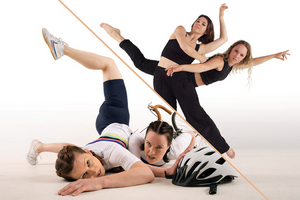 Reviewed by Ray Smith, Friday 23rd April 2021.
Reviewed by Ray Smith, Friday 23rd April 2021.
The Space Theatre, sitting amongst the tangled building site that is the soon to be refurbished Festival Centre, hosted
The Move, two contemporary dance works by local freelance choreographers and dancers.
We gathered in the sanctuary of the Space Theatre foyer, wearing our compulsory masks, having passed through the chaotic rubble and boarded walls of the dusty, dishevelled Adelaide Festival Centre, like survivors in a dystopian novel seeking an oasis of normality in a broken world.
We were here to watch two short dance works by choreographers Lewis Major and Gabrielle Nankivell, in collaboration with Jo Stone. Major's work, Satori, was programmed first and, after a small interval, was to be followed by Nankivell's, Wonder Grit.
The Space Theatre is an intimate and much-loved venue, and is often host to new and innovative works. The theatre has no stage, per se, but rather has raised seating around an open floor space, much in the form of an amphitheatre, and so it was that I found myself in the front row, literally at stage level, a mere metre from the edge of the dance space.
The first piece began, after an acknowledgement of country, in almost complete darkness. A dancer, dressed in black enters, carrying a tube of light not unlike a fluorescent lighting tube, and walks silently, ritualistically towards similar but darkened tubes suspended from the ceiling. As she touches each of the tubes, it too begins to shine, offering a subdued light to the otherwise empty space.
A pas de deux ensues during which the illuminated tube is used by one of the partners to direct the other like a puppeteer, as if it were a stick attached to her body, the movements fluid and well-rehearsed.
As other dancers join the stage, collecting their own illuminated tubes from those suspended, the play of light becomes more complex and organised, the tubes forming undulating lines of light or the shifting boundaries of polygons framing the dancers.
I was reminded of the traditional 'rapper', or sword dances of the northeast of England, where five dancers perform complex, interweaving movements, all the while forming shapes in the air with their swords.
The darkness was cut by these swords of light, and the almost invisible, black-clad dancers became the vehicles for these bright lines as they drew their shapes in the air with them. The contrast of the pale skin of a solo dancer dressed only in shorts, was like a splash of white paint on a featureless black canvas, his furious, trance like movements starkly lit by the lights of his peers, which changed colour from the hard, brittle white to softer hues of green and blue and intense unforgiving red.
The general feel was one of ritual, and almost tribal ceremony as the pale dancer seemed in awe of the colour shifting lights, in reverence and uncertainty, questioning their motives.
This was a very enjoyable work and, like all well-formed pieces, left the audience intrigued and with more questions than answers.
I should like to see it again from a different angle. Although I enjoy being on the same level as the dancers, hearing their grunts of exertion and the squeak of the feet on the floor, I think my proximity did not allow me to see the overall form of the work.
The second piece, Wonder Grit, featured only two dancers and a bicycle.
The opening gambit was the sound of passing, propeller-driven aircraft, explosive noises and even an air raid siren that appeared to be lifted from a movie about the Second World War. A voiceover spoke of the loss of competitiveness, the fear of losing, the struggle to win. Was the audio war reference about competition? The struggle for victory?
All was revealed, all too starkly, as the two dancers took to the stage in an almost comedic performance of a drama about the rise, fall and attempted recovery of a competitive cyclist. The audience roared with laughter at the vignettes of the dancers mimicking training, competition, victory, loss, injury and the rehabilitation of our intrepid hero, battling accidents and the merciless progression of age.
Was it a reference to the short performance life of a professional dancer? I don't know, and quite frankly I don't much care. It was far too literal and left me cold. When the soundtrack morphed clumsily into a rendition of
Eye of the Tiger, I simply wanted to leave.
The two dancers performed some spectacular solo pieces but they couldn't compete with the juxtaposition of the very corny theatre. The dancing was good, but the drama was not. The audience loved it, but I was just wondering how long I would have to wait for a tram to carry me away from it.
Reader Reviews
To post a comment, you must
register and
login.
 Reviewed by Ray Smith, Friday 23rd April 2021.
Reviewed by Ray Smith, Friday 23rd April 2021. Reviewed by Ray Smith, Friday 23rd April 2021.
Reviewed by Ray Smith, Friday 23rd April 2021.